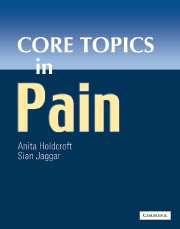Book contents
- Frontmatter
- Contents
- Contributors
- Preface
- Acknowledgements
- Foreword
- General abbreviations
- Basic science abbreviations
- PART 1 BASIC SCIENCE
- PART 2 PAIN ASSESSMENT
- Section 2a Pain measurement
- Section 2b Diagnostic strategies
- PART 3 PAIN IN THE CLINICAL SETTING
- Section 3a Clinical presentations
- 14 Epidemiology of pain
- 15 Pain progression
- 16 Analgesia in the intensive care unit
- 17 The chronic pain patient
- 18 Post-operative pain management in day case surgery
- Section 3b Pain syndromes
- PART 4 THE ROLE OF EVIDENCE IN PAIN MANAGEMENT
- PART 5 TREATMENT OF PAIN
- Section 5a General Principles
- Section 5b Physical treatments
- Section 5c Pharmacology
- Section 5d Psychosocial
- PART 6 SUMMARIES
- Glossary
- Index
16 - Analgesia in the intensive care unit
from Section 3a - Clinical presentations
Published online by Cambridge University Press: 10 December 2009
- Frontmatter
- Contents
- Contributors
- Preface
- Acknowledgements
- Foreword
- General abbreviations
- Basic science abbreviations
- PART 1 BASIC SCIENCE
- PART 2 PAIN ASSESSMENT
- Section 2a Pain measurement
- Section 2b Diagnostic strategies
- PART 3 PAIN IN THE CLINICAL SETTING
- Section 3a Clinical presentations
- 14 Epidemiology of pain
- 15 Pain progression
- 16 Analgesia in the intensive care unit
- 17 The chronic pain patient
- 18 Post-operative pain management in day case surgery
- Section 3b Pain syndromes
- PART 4 THE ROLE OF EVIDENCE IN PAIN MANAGEMENT
- PART 5 TREATMENT OF PAIN
- Section 5a General Principles
- Section 5b Physical treatments
- Section 5c Pharmacology
- Section 5d Psychosocial
- PART 6 SUMMARIES
- Glossary
- Index
Summary
Pain in the ICU is commonly multi-factorial, arising from:
1 Pre-existing disease (e.g. recent surgery and myeloma).
2 Therapeutic devices (e.g. drains, non-invasive ventilation masks and endotracheal tubes).
3 Invasive procedures (e.g. intravenous access).
4 Routine nursing care (e.g. airway suctioning, physiotherapy, mobilization and dressing changes).
5 Monitoring (e.g. oesophageal Doppler).
In order to avoid patient suffering, these nociceptive stimuli require suitable analgesia, using adequate dosages and appropriate regimens.
Why are patients in pain?
1 Staff fear of potent analgesics, particularly with regard to the potential:
— Obscuring of diagnosis.
— Occurrence of adverse side effects (cardiovascular system (CVS), respiratory, gastrointestinal (GIT) system).
— For drug addiction.
2 Staff difficulties with pain assessment.
3 The multi-factorial nature of influences affecting the patients' perception of pain, specifically:
— Expectation of pain.
— Prior pain experiences.
— Emotional state.
— Cognitive processes.
What are the complications of inadequate pain relief?
Inadequate analgesia contributes to:
1 Exhaustion, disorientation and agitation, consequent upon insomnia.
2 An enhanced stress response, characterized by tachycardia, increased myocardial oxygen consumption, hypercoagulability, immunosuppression and persistent catabolism.
3 Pulmonary dysfunction, with guarding of muscles around painful areas leading to restrictive movements of the chest wall and diaphragm.
How can pain be assessed in the intensive care unit?
Clinical pain assessment relies heavily on subjective patient reports (Table 16.1).
- Type
- Chapter
- Information
- Core Topics in Pain , pp. 109 - 116Publisher: Cambridge University PressPrint publication year: 2005



